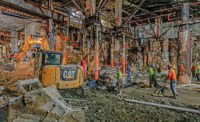The U.S. Army Corps of Engineers� first project funded under the American Recovery and Reinvestment Act was awarded by the Ft. Worth District May 1 to Sundt Construction, Inc., Tempe, Ariz., for construction of the $30-million first phase of a $57-million Warriors in Transition complex to be built at Ft. Bliss, Texas.

Designed to assist injured soldiers in their recovery and re-integration into the Army or civilian life, WT complexes “are a new breed of facilities within the military hierarchy of structures and facilities,” says Tom Mertz, vice president of Sundt’s federal division. “There are so many improvements in treatment for battlefield trauma, including rehabilitation for brain trauma or head injuries. We are honored to be a part of building this facility.”
“There are hospitals and rehabilitation facilities, but not a whole complex like this that assists soldiers and their families in recovery,” says Randall Cephus, public affairs for the Ft. Worth District.
Covering more than 185,000 sq ft, the WT complex will comprise a barracks that will accommodate 232 injured soldiers, a headquarters and administrative building and a Soldier and Family Assistance Center, a single-story, 15,000-sq-ft building that will house social, legal and financial support services. Sundt’s design-build contract for Phase I of the project includes site infrastructure and construction of the barracks facility.
“The complex will be arranged in a campus, community-style layout where the buildings encircle a large courtyard with a walking trail, labyrinth, seating areas and covered canopies,” says Jason Foltyn, senior project manager for the Corps. “This allows for a quiet, relaxing atmosphere, which will facilitate the recovery effort.”
Sundt will also incorporate additional features throughout the facility and site “that reduce tripping hazards and provide additional assistance to the recovering soldiers such as benches with a midpoint handrail-armrest that provides an additional point for the soldier to assist herself/himself onto and off of the bench,” Mertz says.
May 26, Sundt will begin design, and the contractor anticipates breaking ground for construction September 1, 2009. Although the basic design and floor plan were developed by USACE’s Centers of Standardization, “it’s up to the design-build team to figure out how to arrange living unit modules, as well as design and install all the mechanical, structural, electrical and infrastructure,” Mertz says. Because the project is located in the historic district of Ft. Bliss, “maintaining that historic flavor in terms of architecture” will be a priority, he adds. Sundt is working on this and several other design-build projects with Michael Baker Jr., Inc., Pittsburgh, Pa.
| Sector | Military |
|---|---|
| State | Texas |
| Description | $30-million Phase I of Warriors in Transition Complex at Ft. Bliss |
| Value | $57 million |
| Jobs | Seven retained |
| General Contractor | Sundt Construction Inc., Tempe, Arizona |
| Start Date | Design � May 26, 2009 Construction � September 1, 2009 |
| Project Delivery | Design-Build |
Sundt is currently under contract for $330 million in additional projects at Ft. Bliss, Mertz says, so “the surrounding community of suppliers and subcontractors is prepared for the type of work going on here.” Sundt anticipates retaining seven full time equivalent jobs to support this ARRA contract, but is not responsible for reporting all of the jobs retained or created by subcontractors, Mertz says.
The Corps is currently soliciting a small business set-aside Multiple Award Task Order Contract under the HUBZone, for Phase 2 of the project to construct the administrative building and soldier and family activity center, says Lisa C. Billman, Corps contracting officer. “Additionally, Sundt is obligated to subcontract 70% of its work to small businesses to complete Phase 1 requirements. The opportunities for small business under both phases of the WT contract will ensure their inclusion in the process as we help to stimulate the economy while taking care of soldiers and their families.”
Once the small business contract is awarded, any remaining funds not needed to execute the contract will be returned to the overall ARRA program to support other projects, Billman says.
The WT complex at Ft. Bliss is the first of nine MILCON Army projects and one of two WT complexes to be funded under the ARRA, Cephus says. “The second WT complex will be a $43-million facility to be constructed at Ft. Campbell, Ky.”
On January, 9, 2009, the Army Corps of Engineers broke ground at Ft. Riley, Kansas, on the first WT complex, but that one was not funded through the ARRA. The Ft. Riley complex is scheduled for completion in late June, and the WT complex at Ft. Bliss is scheduled for completion by the end of 2010. “Thirty-four installations have plans to receive WT Complex facilities world-wide,” Cephus says.
Other MILCON projects to receive ARRA funding include: a Child Youth Center at Fort Stewart, Georgia and Child Development Centers at Ft. Carson, Colo.; Fort Drum, N.Y.; Fort Bragg, N.C.; Fort Hood, Texas; Fort Belvoir, Va.; and Fort Eustis, Va.




